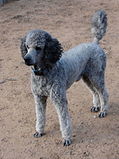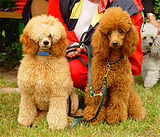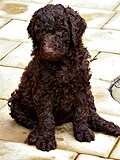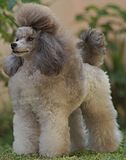Poodle: Difference between revisions
| Line 191: | Line 191: | ||
Of note is this breed's keen sense for instinctive behavior. In particular, [[territorial marking|marking]] and hunting drives are more readily observable than in most other breeds. Classified as highly energetic, poodles can also get bored fairly easily, and have been known to get creative about finding mischief.<ref>{{cite web|title=Poodle Temperament: What You Should Know About Poodle Personality|url=http://www.dog-info.org/poodle-temperament.html|publisher=http://www.dog-info.org/}}</ref> Poodles are highly trainable dogs that rarely need to be told what to do more than a few times and any of the three types will pass through an advanced obedience class with flying colours. A dog of this breed will do exceedingly well at any dog sport asked of it, including [[dog agility]], [[flyball]], [[dock diving]], field [[tracking]], and even [[schutzhund]]. |
Of note is this breed's keen sense for instinctive behavior. In particular, [[territorial marking|marking]] and hunting drives are more readily observable than in most other breeds. Classified as highly energetic, poodles can also get bored fairly easily, and have been known to get creative about finding mischief.<ref>{{cite web|title=Poodle Temperament: What You Should Know About Poodle Personality|url=http://www.dog-info.org/poodle-temperament.html|publisher=http://www.dog-info.org/}}</ref> Poodles are highly trainable dogs that rarely need to be told what to do more than a few times and any of the three types will pass through an advanced obedience class with flying colours. A dog of this breed will do exceedingly well at any dog sport asked of it, including [[dog agility]], [[flyball]], [[dock diving]], field [[tracking]], and even [[schutzhund]]. |
||
A typical poodle of any size should be reserved with strangers upon first introduction, but as the dog lets it guard down and gets to know the individual it should reveal a warm and personable disposition with a jolly sense of humor. Any sign of nervousness or neurosis is atypical and not proper form. Of the three types, Standard Poodles are the most highly recommended for families with children, including small ones |
A typical poodle of any size should be reserved with strangers upon first introduction, but as the dog lets it guard down and gets to know the individual it should reveal a warm and personable disposition with a jolly sense of humor. Any sign of nervousness or neurosis is atypical and not proper form. Of the three types, Standard Poodles are the most highly recommended for families with children, including small ones, so long as the household is orderly and fun.<ref>http://www.animalplanet.com/breed-selector/dog-breeds/non-sporting/poodle-standard.html</ref |
||
<ref>http://www.petwave.com/Dogs/Breeds/Poodle/Personality.aspx</ref> |
|||
Snappy, vicious behavior is a serious fault, and in the case of the smaller classes of poodles ( of a size enough to fit inside a woman's shoulder bag or handbag) should not be tolerated under any circumstance: it is often the sign of a poorly bred or incredibly spoiled dog that never walks on a lead, never is asked to eat out of a bowl but rather is hand fed, and never has been taught to obey its master. Such a dog thinks of its master as property and needs to be taught manners at once before it bites someone.<ref>http://www.pethealth101.com/breeds/toy_poodle.shtml</ref> |
Snappy, vicious behavior is a serious fault, and in the case of the smaller classes of poodles ( of a size enough to fit inside a woman's shoulder bag or handbag) should not be tolerated under any circumstance: it is often the sign of a poorly bred or incredibly spoiled dog that never walks on a lead, never is asked to eat out of a bowl but rather is hand fed, and never has been taught to obey its master. Such a dog thinks of its master as property and needs to be taught manners at once before it bites someone.<ref>http://www.pethealth101.com/breeds/toy_poodle.shtml</ref> |
||
Revision as of 03:36, 17 July 2014
| poodle | |||||||||
|---|---|---|---|---|---|---|---|---|---|
 A white Standard Poodle in the Scandinavian clip, tail not docked. | |||||||||
| Other names | Pudle (Old English)
Caniche Barbone | ||||||||
| Origin | Germany then standardized in France[1] | ||||||||
| |||||||||
| Dog (domestic dog) | |||||||||
The poodle is a group of formal dog breeds, the Standard Poodle, Miniature Poodle and Toy Poodle (one registry organisation also recognizes a Medium Poodle variety, between Standard and Miniature), with many coat colors. Originally bred in Germany as a type of water dog, the breed was standardized in France. The poodle is skillful in many dog sports, including agility, obedience, tracking, and even herding. Poodles have taken top honors in many conformation shows, including "Best in Show" at the Westminster Kennel Club Dog Show in 1991 and 2002, and at the World Dog Show in 2007 and 2010.
Toy Poodles won "Best in Show" at Crufts in 1966 and 1982. Standard Poodles achieved the award in 1955, 1985, 2002 and 2014. The 2002 winner came from Norway and was the first overseas exhibit to win the Crufts best in show award.[2][3][4]
History

The poodle is believed to have originated in Germany,[1] where it was known as the Pudelhund. Pudel (cognate with the English word "puddle"), is derived from the Low German verb meaning "to splash about", and the word Hund in German means "dog" (cognate with "hound"). The breed was standardized in France, where it was commonly used as a water retriever.[5] Due to the breeds popularity in France, it became established as its national breed.[1]
The European mainland had known the poodle long before it was brought to England. Drawings by German artist Albrecht Dürer established the popular image of the breed in the 15th and 16th centuries. It was the principal pet dog of the late 18th century in Spain, as shown by the paintings of the Spanish artist Francisco Goya. France had toy poodles as pampered favorites during the reign of Louis XVI at about the same period.[6]
The poodle has been bred in at least three sizes, including Standard, Miniature, and Toy. According to the American Kennel Club, the Standard Poodle is the oldest of the three varieties,[7] and was later bred down to the miniature and toy sizes. Despite the Standard Poodle's claim to greater age than the other varieties, some evidence shows the smaller types developed only a short time after the breed assumed the general type by which it is recognized today. The smallest, or Toy variety, was developed in England in the 18th century.

Standard Poodle
Traditionally the Standard Poodle, the largest of the subtypes, was a retriever or gun dog, used in particular for duck hunting and sometimes upland bird hunting. The modern Standard retains many of the traits prized by their original owners: a keen working intelligence that makes the dog easy to command, webbed feet that make it an agile swimmer (all of the poodle's ancestors and descendants had or share the love of water) athletic stamina, and a moisture-resistant, curly coat that acts like a wool jumper in damp conditions. Towards the second half of the nineteenth century their use in hunting declined in favour of their use in circuses and status symbols of the wealthy, so that by the 20th century they were only found as companions or circus dogs.[8]
However, in the past 20 years, some breeders in the United States and Canada have been selecting for dogs with drive for birds in order to revive the breed for hunting, with some great success.[9] The Canadian Kennel Club admitted the Standard Poodle for hunting trials in 1996 and the American Kennel Club in 1998, respectively.[10] As of July 2014, the end results of 20 years of breeding to reawaken the hunting instinct have been dogs that are very eager to please their masters, extreme intelligence that requires special training (-their extreme intelligence is second only to the British Border Collie[11] and thus requires the gunman to be quite specific as to what he wants, unlike most other spaniels and retrievers-) and a dog that has lightning quick reflexes, sprinting hard on command after the downed bird.[12][13] Standard Poodles have been winning titles against the more widely used native breeds like the Chesapeake Bay Retriever and Labrador Retriever.[14] Thus far 13 Standard Poodles have won Master Hunt titles (12 in the United States, 1 in Canada) and several more have won senior and junior titles on both sides of the border. Currently only the United Kennel Club in the US recognizes the Standard Poodle as a Sporting dog, thus in spite of this subtype of poodle being ineligible for field competitions more and more are appearing in the field as waterfowl dogs and hunters of pheasant, the latter especially in the Midwest.[15]
Miniature Poodle
Members of the second variety, the Miniature Poodle, had ancestors that were originally never said to go anywhere near the water. Truffle hunting was widely practiced in England, and later in Spain, France, and Germany, where the edible fungus has always been considered a delicacy. For scenting and digging up the fungus, the smaller dogs were favoured, since they did less damage to the truffles with their feet than the larger kinds. So it is rumored[16] that a terrier was crossed with the poodle to produce the ideal truffle hunter. An 1837 account describes the narrator meeting up with a Frenchman upon a truffle hunt with a pig with the Frenchman lamenting that he did it "for want of a poodle", and earlier pages describe exactly how the dog was trained from the age of four months old to fetch and dig for truffles and carefully carry them back to his master: often the prey drive of his larger cousin was left out of the breeding.[17] Otherwise, the Miniature and Toy varieties remained largely the lap dogs of middle and upperclass ladies, especially in France and the UK. The trade in dyeing and affixing their fur to unusual proportions began with the need to compliment the Victorian and Georgian sensibilities of these women[18], to the point that their status as a dog of the middle and upper classes was quite solid by the time of the founding of the Kennel Club in the 1870s as they were one of the first dog breeds registered.
World War II working dogs
Poodles have been used as working dogs in the military since at least the 17th century. During WWII, Roland Kilbon of the New York Sun, reported that other countries had used dogs in their armies for many years. In his column he quoted Mrs. Milton S. (Arlene) Erlanger, owner of Pillicoc Kennels, a premier breeder of Poodles "The dog must play a game in this thing." Eventually, "With the blessing of the American Kennel Club, the Professional Handlers Association, obedience training clubs across the country, and Seeing Eye, Inc., a nation-wide program known as Dogs for Defense, Inc. was initiated and became the official procurement agency for all war dogs used in the Army, Navy and Coast Guard."[19] Dogs for Defense procured the dogs who were then trained by the Army. In 1942, the Poodle was one of 32 breeds officially classified as war dogs by the Army.
Description
Appearance

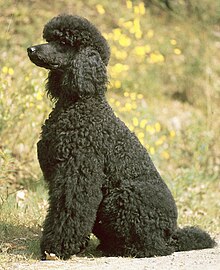
The poodle is an active, intelligent and elegant dog, squarely built, and well proportioned. To ensure the desirable squarely built appearance, the length of body measured from the breastbone to the point of the rump approximates the height from the highest point of the shoulders to the ground. The eyes should be very dark, oval in shape, and have an alert and intelligent expression. The ears should fold over close to the head, set at, or slightly below, eye level. The coat should be of naturally curly texture, dense throughout, although most AKC-registered show dogs have a lion-cut or other, similarly shaven look.
Poodle sizes
Poodles are bred in a variety of sizes, distinguished by adult shoulder (withers) height. The exact height cutoffs among the varieties vary slightly from country to country. The Fédération Cynologique Internationale (FCI) recognizes four sizes of one breed: standard, medium, miniature, and toy.[20] Non-FCI kennel clubs generally recognize three sizes, standard, miniature, and toy, sometimes as sizes of the same breed and sometimes as separate breeds. Only the FCI describes a maximum size for Standard Poodles. France is the country responsible for the breed in the FCI, and in this country, the puppies of all sizes are listed together.[21] The terms royal standard, teacup, and tiny teacup are marketing names, and are not recognized by any major kennel club.
| Size | The Kennel Club (UK) | Australian National Kennel Council | New Zealand Kennel Club | Canadian Kennel Club | American Kennel Club | United Kennel Club | Fédération Cynologique Internationale |
|---|---|---|---|---|---|---|---|
| Standard, Grande | over 38 cm (15 in) | 38 cm (15 in) and over | 38 cm (15 in) and over | over 15 inches (38 cm) | over 15 inches (38 cm) | over 15 inches (38 cm) | over 45 cm to 60 cm (+2 cm) (18 to 24 in) |
| Medium, Moyen | not used | not used | not used | not used | not used | not used | over 35 cm to 45 cm (14 to 18 in) |
| Miniature - Dwarf, Nain | 28 cm to 38 cm (11 to 15 in) | 28 cm to under 38 cm (11 to 15 in) | 28 cm to under 38 cm (11 to 15 in) | over 10 in to under 15 in (25.4 to 38 cm) | over 10 in to 15 in (25.4 to 38 cm) | over 10 in up to 15 in (25.4 to 38 cm) | over 28 cm to 35 cm (11 to 14 in) |
| Toy | under 28 cm (11 in) | under 28 cm (11 in) | under 28 cm (11 in) | under 10 in (25.4 cm) | under 10 in (25.4 cm) | under 10 in (25.4 cm) | 24 to 28 cm (9.4 to 11 in) |
All the Fédération Cynologique Internationale Poodles are in Group 9 Companion and Toy, Section 2 Poodle. All the Kennel Club poodles are in the Utility Group. All three sizes of poodles for the Australian National Kennel Council and the New Zealand Kennel Club are in the Non-sporting Group. The Canadian Kennel Club and the American Kennel Club place standard and miniature sizes in the Non-sporting Group, and the toy size in the Toy Group. The United Kennel Club places the miniature and toy in the Companion Group and the standard poodle in the Gundog Group.
Coat
Unlike most dogs which have double coats, poodles have a single layer coat (no undercoat is present) composed of dense, curly fur[23] that sheds minimally.[24] They could be considered hypoallergenic (though not completely allergen free).[25][26] The poodle does shed, but instead of the fur coming off the dog, it becomes tangled in the surrounding hair. This can lead to matting without proper care.

Texture ranges from coarse and woolly to soft and wavy. Poodle show clips require many hours of brushing and care per week, about 10 hours/week for a Standard Poodle. Poodles are usually clipped down into lower-maintenance cuts as soon as their show careers are over. Pet clips are much less elaborate than show and require much less maintenance. A pet owner can anticipate grooming a poodle every six to eight weeks. Although professional grooming is often costly, poodles are easy to groom at home with the proper equipment.[citation needed]
Corded coat
In most cases, whether a poodle is in a pet or show clip, the hair is completely brushed out. Poodle hair can also be "corded" with rope-like mats similar to those of a Komondor or human dreadlocks. Though once as common as the curly poodle, corded poodles are now rare. Corded coats are difficult to keep clean and take a long time to dry after washing. Any poodle with a normal coat can be corded when its adult coat is in. Corded poodles may be shown in all major kennel club shows.[27][28][29]
Different show clips

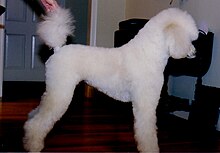
Gennerally, the owners clip their dogs as they want, however, if they want to compete with their dogs show clips are a requirement. Many breed registries allow only certain clips for poodles shown in conformation. In American Kennel Club (AKC) shows, adults must be shown in the "Continental" or "English saddle" clips. Dogs under 12 months old may be shown with a "puppy clip". The AKC allows the "Sporting" clip in Stud Dog and Brood Bitch classes, as well.[citation needed]
Some sources believe the show clips evolved from working clips, which originally provided warmth to major joints when the dogs were immersed in cold water. The rest of the body is shaved for less drag in the water. Others express skepticism at this theory, instead citing the French circus as the origin of the entertaining and unique clips.[citation needed]
Second puppy
The second puppy clip is also called the Scandinavian clip or puppy clip. It was invented by Swedish and Norwegian show groomers in the 1970s. It is the most common one in all sizes for shows in Europe, and is allowed for adult poodles to be shown in the FCI countries. The face, throat, belly, feet and the base of the tail are shaved five to seven days before the show to get a nice, smooth appearance of the shaved areas. The hair on the head is left to form a "topknot", fixed in place using latex bands, because in most European countries, hair spray is banned. The rest of the dog is shaped with scissors. It makes the parts of the dog look fluffy.[citation needed]
Continental clip
In the continental clip, the face, throat, feet and part of the tail are shaved. The upper half of the front legs is shaved, leaving "fluffy pompons" around the ankles. The hindquarters are shaved except for pompons on the lower leg (from the hock to the base of the foot) and optional round areas (sometimes called "rosettes") over the hips. The continental clip is the most popular show clip today.[citation needed]
English saddle clip
The English saddle clip is similar to the continental, except for the hindquarters, which are not shaved except for a small, curved area on each flank (just behind the body), the feet, and bands just below the stifle (knee) and above the hock, leaving four (4) pompons. This clip is now rarely seen in standard poodles.[citation needed]
Pet clips
Pet clips can be as simple or as elaborate as owners wish. The hair under the tail should always be kept short to keep feces from matting in the dog's curls. Most owners also keep the feet and face clipped short to prevent dirt from matting between toes, tear stains on lighter-coated poodles and food from matting around the dog's muzzle. Beyond these sanitary requirements, desired clips depend on owners' preferences. Some owners maintain a longer clip in winter than summer. The coat is groomed often with a wire slicker brush to remove tangles and prevent matting.[citation needed]
Hunting
in the past 20 years in North America, as has been intimated earlier in this article, Standard Poodles have begun to be put back to their original purpose as duck and game bird hunters.The more commonly acceptable clips seen in the show ring and the local groomer's have proven extremely impractical in action. In the US and Canada, most hunters are male, lower to upper middle class, and strongly dislike being seen with a dog that has had an effete reputation. Dyeing a white Standard Poodle's hair flamboyant colours and putting bows in their hair has been a habit since the days well-to-do French ladies got their hands on them, but is unnecessary in the field for hiding in blinds.
The clips otherwise do not guard against the pitfalls of chasing after ducks, geese, turkey, and pheasant: Continental clips, for example, shave the rump of the dog too close to the skin to provide enough warmth in water below 10 °C in a Quebec winter and the fancier cuts that require the hair to be blown straight can easily get the dog stuck in bramble like a fly in a spiderweb. The lion cut, popular in the UK, is a disaster: an exposed flank makes the dog an easy mark for mosquitoes, black flies, and cuts, and because poodles have lost much bodyfat over the past 150 years, exposed skin in cold weather can make them very sick. .Conditions are often muddy or snowy and either can cause longer hair to become a matted mess or cause ice and slush to become impacted into the fur, not to mention the upkeep of repairing the damage at the groomer's shop becomes prohibitively expensive and time consuming.
Most hunters have their dogs sport a low maintenance modification of the Puppy, Sporting, or Continental clip[30][31] The cut typically shears the dog all over evenly a quarter inch to an inch and a half off the skin, depending on the time of year, and usually leaves the face shaven so the dog can see well. Some hair on the ankles and on top of the head may be left longer for warmth in the water, and all that is required thereafter is a scrubbing in warm soapy water after a day on the hunt and a little patience to remove the burrs the dog's hair collects in the bushes. [32] An insulated orange jacket in colder weather is preferred.
- Different clips
-
At three year-old silver male Standard Poodle in Pet clip. Weight is 75 lb (34 kg), measures 27 in (69 cm) at the withers.
-
White Standard Poodle. Continental clip
-
Miniature black Poodle, in Continental clip
-
A medium-sized poodle in the Scandinavian clip
-
Standard poodle apricot, Modern clip
Colours

Poodles have either a solid-colored or parti-colored coat. The dogs have a wide variety of coloring, including white, black, brown, parti, silver, gray, silver beige, apricot, red, cream, sable, and patterns such as phantom and brindle.[33]
For solid-colored poodles, the coat is an even and solid color at the skin. In blues, grays, silvers, browns, cafe-au-laits, apricots and creams, the coat may show varying shades of the same color. This is frequently present in the somewhat darker feathering of the ears and in the tipping of the ruff. While clear colors are preferred by registries, such natural variation in the shading of the coat is not to be considered a fault. Brown and cafe-au-lait poodles have liver-colored noses, eye rims and lips, dark toenails and dark amber eyes. Black, blue, gray, silver, cream and white poodles have black noses, eye rims and lips, black or self-colored toenails and very dark eyes. In the apricots, while the foregoing coloring is preferred, liver-colored noses, eye rims and lips, and amber eyes are permitted, but are not desirable. Incomplete color of nose, lips and eye rims, or a "mismatched" color are considered faults by registries.
Parti-colored poodles are recognized in poodle history as the original coloring of the poodle.[34] A parti poodle has solid-colored patches over a white coat. The coat will usually be white and colored in equal amounts, though it can vary with a larger percent of white. Registries prefer that parti poodles have the same points as its correlating solid-colored descendants. Brown and white parti poodles have liver-colored noses, eye rims and lips, dark or self-colored toenails and amber eyes. This is also permitted, but not preferred, in apricot and white parti poodles. Black/white, Blue/white, and silver/white poodles have black noses, eye rims and lips, black or self-colored toenails and very dark eyes.
Phantom poodles have the coloring of a Doberman Pinscher, with a lighter color appearing on their "eyebrows", muzzle and throat, legs and feet and below their tail. Like Dobermans, phantom poodles have either a black or brown main coat with a tan (usually apricot or red) lighter colorings around the eyebrows, muzzle, throat, legs, feet, and below their tail.
When the dog has markings that resemble those of a tuxedo, it is called a "tuxedo" poodle. The upper coat is solid: head, back, tail; and the lower coat is white: neck, chest, abdomen, and legs, making up usually 40% or more of the coat.
- Different colours
-
Sable coloured Poodle
-
Red and apricot Poodles
-
A brown Standard Poodle at five weeks
-
Phantom Poodles
-
Solid gray coated Poodle
Temperament

Of note is this breed's keen sense for instinctive behavior. In particular, marking and hunting drives are more readily observable than in most other breeds. Classified as highly energetic, poodles can also get bored fairly easily, and have been known to get creative about finding mischief.[35] Poodles are highly trainable dogs that rarely need to be told what to do more than a few times and any of the three types will pass through an advanced obedience class with flying colours. A dog of this breed will do exceedingly well at any dog sport asked of it, including dog agility, flyball, dock diving, field tracking, and even schutzhund.
A typical poodle of any size should be reserved with strangers upon first introduction, but as the dog lets it guard down and gets to know the individual it should reveal a warm and personable disposition with a jolly sense of humor. Any sign of nervousness or neurosis is atypical and not proper form. Of the three types, Standard Poodles are the most highly recommended for families with children, including small ones, so long as the household is orderly and fun.Cite error: A <ref> tag is missing the closing </ref> (see the help page).
Snappy, vicious behavior is a serious fault, and in the case of the smaller classes of poodles ( of a size enough to fit inside a woman's shoulder bag or handbag) should not be tolerated under any circumstance: it is often the sign of a poorly bred or incredibly spoiled dog that never walks on a lead, never is asked to eat out of a bowl but rather is hand fed, and never has been taught to obey its master. Such a dog thinks of its master as property and needs to be taught manners at once before it bites someone.[36]
Health
The most common serious health issues of Standard Poodles (listed in order of the number of reported cases in the Poodle Health Registry (as of August 20, 2007) are Addison's disease, gastric dilatation volvulus (GDV = bloat/torsion), thyroid issues (hyperthyroid and hypothyroid), tracheal collapse, epilepsy, sebaceous adenitis, juvenile renal disease, hip dysplasia, and cancer. Standard Poodles are also susceptible to some health issues usually too minor to report to the health registry. The most common of these minor issues is probably ear infection. Ear infections are a problem in all poodle varieties because their nonshedding coat grows into the ear canal, where it traps wax and dirt. Ear problems can be minimized by proper ear care, including regular cleaning and plucking of hair within the ear canal. A veterinarian should be consulted if the dog shows signs of an ear infection.
Addison's disease
Addison's disease is (as of August 20, 2007) the illness most commonly reported to the Poodle Health Registry. The number of reported cases is nearly twice as high as the next most common problem (GDV). Addison's disease is characterized by insufficient production of glucocorticoid and/or mineralocortoid in the adrenal cortex (near the kidneys). Addison's is often undiagnosed because early symptoms are vague and easily mistaken for other conditions. Standard Poodles with unexplained lethargy, frequent gastric disturbances, or an inability to tolerate stress should be tested for it. Addison's can cause fatal sodium/potassium imbalances, but if caught early and treated with lifelong medication, most dogs can live a relatively normal life.[citation needed]
Gastric dilatation volvulus
Standard poodle owners should take special note of the high incidence of GDV in this breed. Excess gas trapped in the dog's stomach causes "bloat". Twisting of the stomach (volvulus or "torsion") causes or is caused by excess gas. Symptoms include restlessness, inability to get comfortable, pacing, or retching without being able to bring up anything. The dog's abdomen may be visibly swollen, but bloat or torsion can occur without visible swelling. A dog with GDV requires immediate veterinary care. The dog's survival usually depends on whether the owner can get to a veterinarian in time.[citation needed] GDV risk is increased with faster eating and a raised feeding bowl.[37]
Longevity
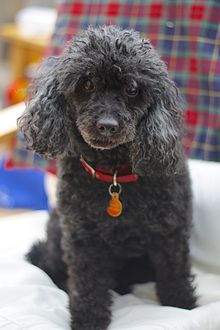

Standard Poodles in UK, Denmark and USA/Canada surveys had a median lifespan of 11.5 to 12 years.[38] In a UK survey, the most common causes of death were cancer (30%), old age (18%), GDV (6%), and cardiac disease (5%).[39]
Miniature and Toy Poodles in UK surveys had median lifespans of 14 to 14.5 years.[38] In Miniatures, the leading cause of death was old age (39%).[39] In Toys, the leading causes of death were old age (25%), and kidney failure (20%).[39]
Some Toy Poodles can live up to 20 years, if they have healthy lives and are not overweight. The oldest poodle that ever lived was Lady who lived to be 28 years and 218 days old. She was born in 1908 and died on August 6, 1937.
Common illnesses
- Addison's disease (hypoadrenocorticism)[40]
- Cataracts[40][41]
- Congenital heart disease
- Chronic active hepatitis[40]
- Cushing's syndrome (hyperadrenocorticism)[40][41]
- Distichiasis
- Entropion
- Epilepsy[42]
- Gastric dilatation volvulus (Standard)[42]
- Gastric torsion
- Glaucoma[41]
- Intervertebral disc degeneration
- Lacrimal duct atresia
- Legg–Calvé–Perthes syndrome
- Progressive retinal atrophy
- Patellar luxation (Toy and Miniature)[41]
- Trichiasis
- Urolithiasis
- Hip dysplasia (Standard)[42]
- Hypothyroidism[42]
- Mitral valve disease[43]
- Osteosarcoma
- Patent ductus arteriosus
- Sebaceous adenitis
- Von Willebrand disease
Reproduction
| Size | Average litter size at birth |
Range | Stillborn (%) | Early neonatal mortality (%) |
|---|---|---|---|---|
| Standard | 7.0 | 2-12 | 2.5 | 1.7 |
| Medium | 3.7 | 1-10 | 1.8 | 3.6 |
| Miniature | 3.0 | 1-8 | 2.5 | 2.5 |
| Toy | 2.4 | 1-4 | 2.5 | 3.0 |
Breed size is correlated with litter size and Standard Poodles have the highest litter size followed by Medium, Miniature and Toy. Toy Poodles have one of the smallest litter size of all breeds.[44] The stillborn rate and early neonatal mortality (death within 1 week from birth) in poodles are lower than the average across all breeds.[45]
Poodle mixes

Poodles are crossed with other breeds for various reasons, and the resulting puppies (called designer dogs) are described by whimsical portmanteau words, such as cockapoo or spoodle (Cocker Spaniel), maltipoo (Maltese), goldendoodle, labradoodle (Labrador), Schnoodle (Schnauzer), pekepoos (Pekingese), Cavapoo (Cavalier King Charles), Bernedoodle (Bernese Mountain Dog) and many others.
A cross between a shedding breed and a poodle (which does not shed much) does not reliably produce a nonshedding dog. Traits of puppies from crossbreedings are not as predictable as those from purebred poodle breedings, and the crosses may shed or have unexpected or undesirable qualities from the parent breeds.
Poodle crossbreds (also called hybrids) are not recognized by any major breed registry, as crossbreds are not one breed of dog, but two. If both parents are registered purebreds but of different breeds, it is still not possible to register a puppy as two different breeds. Some minor registries and Internet registry businesses will register dogs as any breed the owner chooses with minimal or no documentation; some even allow the breeder or owner to make up a new "breed name".
Hypoallergenic qualities
Poodles are often cited as a hypoallergenic dog breed. Their individual hair follicles have an active growth period that is longer than that of many other breeds of dogs; combined with the tightly curled coat, which slows the loss of dander and dead hair by trapping it in the curls, an individual poodle may release less dander and hair into the environment. In addition, most poodles are frequently brushed and bathed to keep them looking their best; this not only removes hair and dander, but also controls the other potent allergen, saliva.[46]
Although hair, dander, and saliva can be minimized, they are still present and can stick to "clothes and the carpets and furnishings in your home"; inhaling them, or being licked by the dog, can trigger a reaction in a sensitive person. An air cleaner, air duct outlet and vacuuming with a vacuum cleaner with a HEPA filter can help clear dander floating in the air.[47]
The word hypoallergenic, when referring to a dog, is also a misconception; all dogs shed. Poodles shed hair in minimal amounts, and also release dander, but are not as likely to trigger allergies as much as many other breeds.
Famous poodles

- Boye, pet of Prince Rupert of the Rhine (1619–1682), was killed at the Battle of Marston Moor.[48]
- Charley, pet of Nobel Prize-winning author John Steinbeck, a black (referred to as "blue" in the book) Standard Poodle, played Charley in the TV miniseries "Travels with Charley: In Search of America", based on Steinbeck's 1961 book of the same name.
- Derek, pet of Patrick Swayze[49][50]
- Rhapsody in White ("Butch"), the Standard Poodle featured in the movie "Best in Show".
- Roly was featured in the BBC's "EastEnders" for eight years.
- Atma and Butz, poodles owned by philosopher Arthur Schopenhauer
- In Goethe's Faust, Mephistopheles first appears to Faust in the form of a black poodle.
- Darla the Poodle who plays Buffalo Bill's poodle Precious in The Silence of the Lambs (film).
Notes
note 1. ^ fur is defined by the Oxford English Dictionary as "the short, soft hair of certain animals"[51] whereas hair is defined as "any of the fine thread-like strands growing from the skin of mammals and other animals, or from the epidermis of a plant."[52]
References
- ^ a b c "Poodle (breed of dog)." Encyclopædia Britannica Ultimate Reference Suite. Chicago: Encyclopædia Britannica, 2011.
- ^ Dogworld: Digital Crufts Edition (2010): p. 87
- ^ Dogworld: Digital Crufts Edition (2010): p. 84
- ^ "Norwegian poodle wins Crufts". BBC News. 10 March 2002. Retrieved 28 December 2009.
- ^ "poodle - definition of poodle by the Free Online Dictionary, Thesaurus and Encyclopedia". The Free Dictionary.
- ^ "American Kennel Club - Poodle History". Akc.org. Retrieved 2010-01-18.
- ^ "From American Kennel Club site".
- ^ http://www.poodlehistory.org/PCIRCUS1.HTM
- ^ http://www.denverpost.com/sports/ci_8307818
- ^ http://www.fleetfiretimbers.com/FFT/Articles/TheUltimateFooFooReturnsToItsHistoricRoots.htm
- ^ http://www.stanleycoren.com/e_intelligence.htm
- ^ https://m.youtube.com/watch?v=cOEoAWACavI
- ^ http://www.waow.com/story/21725061/2013/03/19/outdoors-with-lauren-hunting-poodle
- ^ http://www.dec.ny.gov/docs/administration_pdf/1008duckdogs.pdf
- ^ http://www.startribune.com/sports/outdoors/35629444.html
- ^ "The Poodle. Part 3". Chestofbooks.com. Retrieved 2010-01-18.
- ^ The Gardener's Magazine..., J. C. Louden, ed., vol. III (London 1837)
- ^ http://www.slate.com/articles/news_and_politics/explainer/2004/02/why_are_poodle_haircuts_so_weird.html
- ^ Carter Isaacson, Suzanne. "Poodles in WWII". Poodle History Project. Retrieved 5 February 2013.
- ^ "Fédération Cynologique Internationale Group 9, Section 2, Poodle". Fci.be. Retrieved 2010-01-18.
- ^ "List of poodle puppies registered to the French Kennel Club". scc.asso.fr. Retrieved 2006-02-18.
- ^ Fédération Cynologique Internationale breed nomenclature
- ^ "What is the difference between hair and fur?". Scientific American. Sciam.com. 2001-02-20. Retrieved 2010-01-18.
- ^ "Canine Lymphoma". Marvistavet.com. Retrieved 2011-04-21.
Most breeds have hairs in all different stages of the growth-shed cycle at the same time. A few breeds [incl. poodle] have all hairs in the same stage of growth-shed at the same time.
- ^ Allergic to Dogs, Is Any Dog Safe? Allergy site from an MD. Poodles, airedales, and schnauzers are cited as dogs that only shed their skin every 21 days, and so may be less of a problem for allergic people.
- ^ Grady, Denise (February 5, 1997). "Nonallergenic Dog? Not Really". The New York Times. Retrieved 2011-04-21. How hypoallergenic the dog is may vary with the individual dog and the individual person.
- ^ "American Kennel Club: Poodle Breed Standard. Retrieved May 12, 2007". Akc.org. Retrieved 2010-01-18.
- ^ Dogdomain.com[dead link], Fédération Cynologique Internationale: Poodle Breed Standard. Retrieved May 12, 2007
- ^ "United Kennel Club: Standard Poodle Breed Standard. Retrieved May 12, 2007".
- ^ http://www.quailforever.org/page/dogbreeds.jsp
- ^ http://billingsgazette.com/news/features/outdoors/feature-photo-hunting-poodle/article_e4ae8cb4-348b-56ce-a933-97df91bac11d.html
- ^ http://www.gundogmag.com/2011/09/06/gun-dog-breeds-standard-poodle/
- ^ "American Kennel Club - Poodle". Akc.org. Retrieved 2012-08-23.
- ^ "Poodle History Project". Poodlehistory.org. Retrieved 2012-08-23.
- ^ "Poodle Temperament: What You Should Know About Poodle Personality". http://www.dog-info.org/.
{{cite web}}: External link in|publisher= - ^ http://www.pethealth101.com/breeds/toy_poodle.shtml
- ^ "Non-dietary risk factors for gastric dilatation-volvulus in large and giant breed dogs" (PDF). Retrieved 2012-12-16.
- ^ a b Pullman.com Dog Longevity Web Site. Compiled by K. M. Cassidy. Retrieved June 28, 2007.
- ^ a b c Thekennelclub.org.uk, Kennel Club/British Small Animal Veterinary Association Scientific Committee. 2004. Purebred Dog Health Survey. Retrieved June 28, 2007.
- ^ a b c d Poodleclugofamerica.org Poodle Club of America: Health Issues in Poodles. Retrieved May 5, 2007
- ^ a b c d UPEI.ca, Canine Inherited Disorders Database: Poodle. Retrieved May 5, 2007
- ^ a b c d Canadasguidetodogs.com Standard Poodle, Canada's Guide to Dogs, Retrieved May 5, 2007
- ^ "Poodle Health Problems". Napoleon.org.uk. Retrieved 2010-01-18.[dead link]
- ^ a b Attention: This template ({{cite doi}}) is deprecated. To cite the publication identified by doi:10.1016.2Fj.theriogenology.2010.10.034, please use {{cite journal}} (if it was published in a bona fide academic journal, otherwise {{cite report}} with
|doi=10.1016.2Fj.theriogenology.2010.10.034instead. - ^ a b Attention: This template ({{cite doi}}) is deprecated. To cite the publication identified by doi:10.1016/j.theriogenology.2011.12.023, please use {{cite journal}} (if it was published in a bona fide academic journal, otherwise {{cite report}} with
|doi=10.1016/j.theriogenology.2011.12.023instead. - ^ "Hair vs Fur". Dogplay.com. Retrieved 2010-01-18.
- ^ [1] Mayo Clinic
- ^ "Poodle History Project: Military Dogs. Retrieved May 12, 2007". Poodlehistory.org. Retrieved 2010-01-18.
- ^ "Which dog? With who?". Dogs4sale.com.au. Retrieved 2010-01-18.
- ^ "Companions to genius". Poodlehistory.org. Retrieved 2010-01-18.
- ^ Askoxford.com. "Oxford Dictionaries, Ask Oxford - fur". Askoxford.com. Retrieved 2010-01-18.
- ^ Askoxford.com. "Oxford Dictionaries, Ask Oxford - hair". Askoxford.com. Retrieved 2010-01-18.

